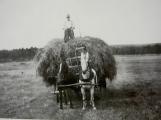3
Farming in the late 1800's, North Shore, Nova Scotia, CanadaCirca 1890
North Shore, Nova Scotia, Canada
 Credits:
Credits:North Shore Archives, CSHC
4
Hay was vital to the farmer once he had livestock. His horse needed hay as did his few cows which had to be kept in a barn over winter. Haying was a laborious task, requiring hand raking originally, piling it on to wagons and then getting it under cover. Surplus would be made into ricks, or sold to add to the income. If he was lucky a second crop might be possible, depending on the maritime weather.Dairy cows were gradually introduced, enabling the wife and daughters to make butter, some of which could be sold or exchanged. Until the arrival of milking machines, the hand churning was a slow process. Dog tread-mill churns helped the busy wife and freed her to do other chores.
Keeping the cream or butter fresh, without refrigeration, was a problem - the wells became useful places to hang containers of milk, cream or butter.
Winter saw the farmer move to the woodlot; having cleared half his land, the remainder, left in wood, gave him an income, provided he could get the wood to a roadside for collection. Farmers shared saws and helped each other with the major tasks required of farming.
In a good year a farmer might have surplus hay to sell, but extra eggs or butter were bartered or later taken to the local store for sale. Thus farming was an industrious occupation, but not an industry until the coming of the railway, better roads and eventually motors which enabled the transport of products. In the 1920's the building of the Creamery in Tatamagouche encouraged farmers to keep dairy cattle, supplying the cream for the production of butter.
Advances were made and there is a record in a copy of the 1883 Pictou News of a 'draining machine'. It was demonstrated on Mr Kitchin's Stock Farm. Made of cast steel, it consisted of a large wheel which worked on the principle of a dredging machine, set between two others wheels some 7 feet (2 meters) apart, and drawn by two strong horses. By means of certain levers, and from his seat the manager could control the machine and remove some 3 inches (7.5 cms) of soil each time it passed up and down. This continued until a depth of some 3 feet (1 meter) was reached. The newspaper thought it was destined to work a revolution in farming!